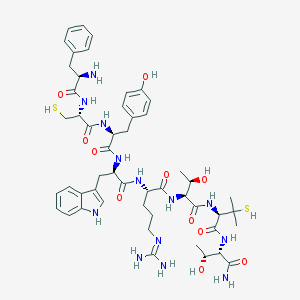

You can:
| Name | D-Phe-Cys-Tyr-D-Trp-Arg-Thr-Pen-Thr-NH2 |
|---|---|
| Molecular formula | C51H71N13O11S2 |
| IUPAC name | (2R)-N-[(2S,3R)-1-amino-3-hydroxy-1-oxobutan-2-yl]-2-[[(2S,3R)-2-[[(2S)-2-[[(2R)-2-[[(2S)-2-[[(2R)-2-[[(2R)-2-amino-3-phenylpropanoyl]amino]-3-sulfanylpropanoyl]amino]-3-(4-hydroxyphenyl)propanoyl]amino]-3-(1H-indol-3-yl)propanoyl]amino]-5-(diaminomethylideneamino)pentanoyl]amino]-3-hydroxybutanoyl]amino]-3-methyl-3-sulfanylbutanamide |
| Molecular weight | 1106.33 |
| Hydrogen bond acceptor | 15 |
| Hydrogen bond donor | 17 |
| XlogP | -0.6 |
| Synonyms | BDBM85334 H-D-Phe-Cys-Tyr-D-Trp-Arg-Thr-Pen-Thr-NH(2) D-Phe-Cys-Tyr-D-Trp-Arg-Thr-Pen-Thr-NH(2) H-D-Phe-Cys-Tyr-D-Trp-Arg-Thr-Pen-Thr-NH2 |
| Inchi Key | GLWPFSWTTGSQRY-FGHAYEPSSA-N |
| Inchi ID | InChI=1S/C51H71N13O11S2/c1-26(65)39(42(53)68)62-49(75)41(51(3,4)77)64-48(74)40(27(2)66)63-44(70)35(15-10-20-56-50(54)55)58-46(72)37(23-30-24-57-34-14-9-8-13-32(30)34)60-45(71)36(22-29-16-18-31(67)19-17-29)59-47(73)38(25-76)61-43(69)33(52)21-28-11-6-5-7-12-28/h5-9,11-14,16-19,24,26-27,33,35-41,57,65-67,76-77H,10,15,20-23,25,52H2,1-4H3,(H2,53,68)(H,58,72)(H,59,73)(H,60,71)(H,61,69)(H,62,75)(H,63,70)(H,64,74)(H4,54,55,56)/t26-,27-,33-,35+,36+,37-,38+,39+,40+,41-/m1/s1 |
| PubChem CID | 11804285 |
| ChEMBL | N/A |
| IUPHAR | N/A |
| BindingDB | 85334 |
| DrugBank | N/A |
Structure |  |
| Lipinski's druglikeness | This ligand has more than 5 hydrogen bond donor. This ligand has more than 10 hydrogen bond acceptor. This ligand is heavier than 500 daltons. |
You can:
| GLASS ID | Name | UniProt | Gene | Species | Length |
|---|---|---|---|---|---|
| 99637 | Delta-type opioid receptor | P41143 | OPRD1 | Homo sapiens (Human) | 372 |
| 460110 | Delta-type opioid receptor | P79291 | OPRD1 | Sus scrofa (Pig) | 228 |
| 99634 | Kappa-type opioid receptor | P41144 | OPRK1 | Cavia porcellus (Guinea pig) | 380 |
| 99636 | Kappa-type opioid receptor | P41145 | OPRK1 | Homo sapiens (Human) | 380 |
| 99635 | Mu-type opioid receptor | P97266 | OPRM1 | Cavia porcellus (Guinea pig) | 98 |
| 555843 | Mu-type opioid receptor | P35372 | OPRM1 | Homo sapiens (Human) | 400 |
zhanglab![]() zhanggroup.org | +65-6601-1241 | Computing 1, 13 Computing Drive, Singapore 117417
zhanggroup.org | +65-6601-1241 | Computing 1, 13 Computing Drive, Singapore 117417